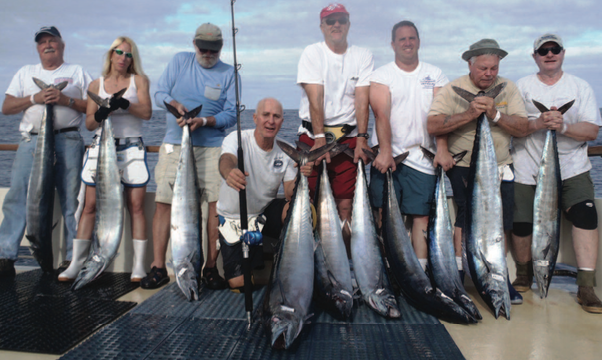BY LARRY BROWN
No other fish in the ocean gets your blood boiling more than wahoo. Wahoo is the quintessential fish for adrenaline junkies. It is not for the slow or weak-hearted or guys with cardiac conditions.
We were headed directly to the Ridge where the boats currently in the zone were reporting excellent wahoo fishing. Intrepid Captain Sam announced we were 30 minutes away and to get the trolling jigs in the water. Adrenaline and anticipation were palpable. And then it happened. Two of the trolling jigs were hit. When the other two trollers were retrieving their jigs, they too were nailed. Everybody launched their bombs and jigs.
The wahoo were everywhere, slashing at baits, bombs and jigs. Free swimmers could be seen in the crystal clear, cobalt blue water casually swallowing chum, and when enticed by a hooked bait they became beautiful and as many believe, the best-eating fish in the ocean.
BOMBS, BAIT OR JIGS?
There are four primary ways to catch a wahoo: bait, bombs, jigs and trolling. What is the best way? Sorry, there is no single answer. The most effective technique one day simply may not work the next day. There are specific conditions and signs that will dictate which method will reign supreme on any given day, but you will likely not know in advance. Your job is to be prepared for any condition and nimble to switch techniques to fit the current conditions.
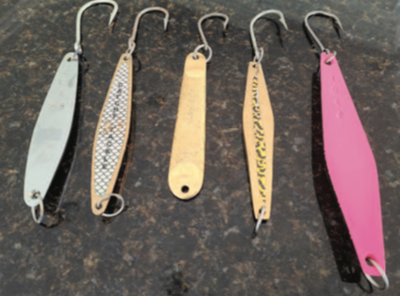
I used to think that a sardine looks, smells and tastes more like real bait than a jig or bomb, so more wahoo must ultimately be caught on a live bait. Next, a jig is shaped and swims more like a real bait than a bomb, so jigs should normally perform better than bombs. Bombs look nothing like bait, don’t swim and appear more appropriate for earrings for their typical crazed wahoo selves.
Wahoo jumping 10 feet out of the water just 20 feet away from the boat certainly gets your heart racing. Your adrenaline is pumping even before you’re bit, and chaos reigns on the deck as anglers are racing back and forth, zigging and zagging, over and under lines and fellow anglers trying but failing to keep up with wahoo rooster-tail- ing through the water at 60 mph.
We dream about this type of wahoo fishing. And for the lucky few, we experience it — up close and personal. This is what we pray for and pay for on the 8- to 10-day fall and winter trips on one of the luxury sportfishing vessels out of San Diego. Once you experience it, you will become addicted and want to take trips every year.
Wahoo (Acanthocybium solanderi) is the perfect apex predator of the sea. Streamlined, faster than a speeding bullet, fearless, absolute-giant ogres, but sometimes they are the most effective way to catch wahoo.
There is a strategic sequence to follow to optimize your wahoo catch. First of all, you must understand your enemy. Wahoo are known to be boat-shy. They are pelagic fish and travel hundreds or thousands of miles in their migrations. Arriving in a new area like the Ridge, Alijos Rocks, the Hurricane Bank or the Clarion Buffer Zone, they are likely to be in larger schools, extremely competitive and ravenous and will attack anything in the water.
These are the dream conditions for wahoo fishing and suggest a bomb is likely the preferred op- tion. If they are going to hit everything in sight, why not present something which is 80% hook and more difficult to grab and spit out.
As these schools get hammered by the sportboats and the wahoo see their brothers and sisters starting to disappear during successive wild feeding frenzies, they become progressively more cautious and persnickety with their diet. That’s frequently when jigs start outperforming bombs. I’m sure this is because a jig actually is made to look like and behave more like a bait, especially compared to a multi-colored earring screaming through the water.
The problem with a jig is that there is more body for the wahoo to grab and hold and ultimately escape compared to a bomb. Look at the hook-to-body ratio in length and mass of jigs versus bombs.
Finally, as the schools of wahoo have been decimated by the sport- boats and commercial fishers, they become intensely curious and cautious of any potential food in the water. There is also less competition and more time for the wahoo to be selective. This is when wahoo may ignore bombs and jigs and only be fooled by baits.
Sometimes wahoo will only be fooled with very light wire and very small hooks. On some trips, more wahoo are caught on straight fluorocarbon as incidental catch while we are targeting tuna versus target- ing wahoo with wire.
Wahoo fishing is fast and furious and you better have your game plan ready. So let’s discuss bombs, jigs and baits in that order.
BOMBS
Anglers are generally eternal optimists, so let’s all hope we arrive to the grounds and the wahoo are plentiful, stupid and ravenous. Be prepared with your favorite wahoo bomb. My favorite bombs are smaller, low-profile, hard-bodied projectiles that you can toss a mile and retrieve through the water at warp speed with the least fatigue.
Larger, heavier models sink faster (possibly to where the wahoo are lurking) but are more water resistant and more difficult to cast and retrieve, and result in more fatigue and ultimately less total time in the water and fewer wahoo caught.
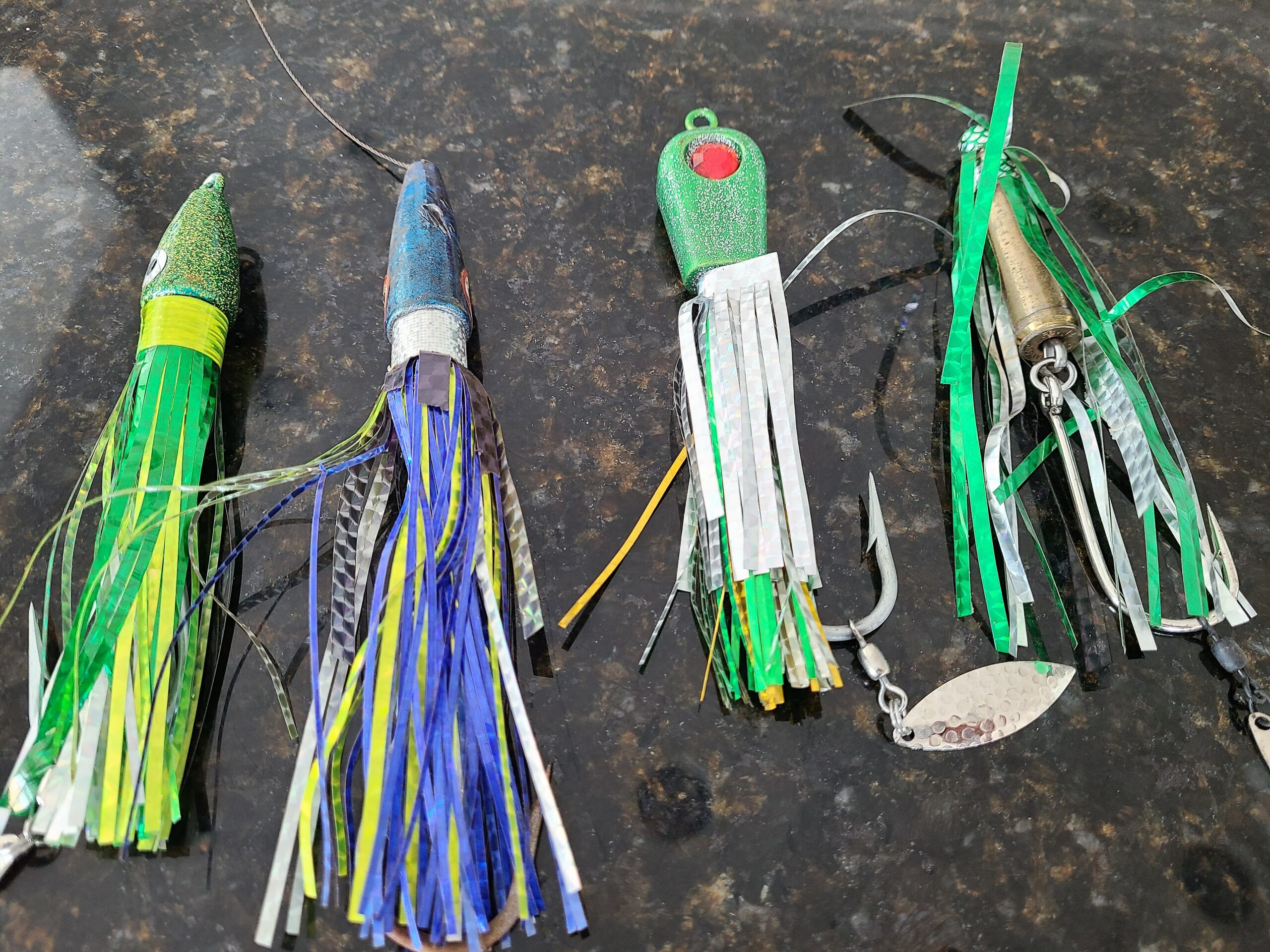
If you are not a great long-distance caster, the larger, heavier models are actually very effective as they sink very fast. Just toss them a short distance upwind, (wind in your face), let them sink for 45 seconds and reel halfway back to the boat as fast as you can and repeat. All the normal wahoo colors are effective, including purple, orange, black, green, etc. Actually, Captain Sam Moore tells us the best color is “speed.”
The best bombs are JRI’s Hooicide, the Catchy Spinner, Captain Jimmy’s or Rudy’s Rude Dog. Bombs will always have a wire leader. Always check the crimps if you purchase pre-wired bombs as they are frequently assembled by cheap labor overseas by non-fishermen who inevitably miss crushing one out of 20 crimps.
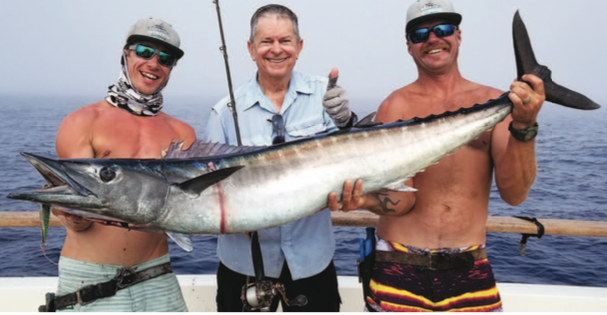
JIGS
The conventional wisdom is that anything shiny will do. Wrong! I have seen wahoo prefer dark jigs, black jigs, yellow with red stripes and orange jigs. I would definitely have a good selection of these and shiny gold and chrome jigs, too.
Wahoo attack their prey from the side. They will often grab the jig like a dog holding a bone. High-density, low-profile (skinny) jigs are better for three reasons: they give the wahoo less surface area to bite down on and hold onto; they have less water resistance, meaning they will be faster and easier on your body; and the wahoo’s ultra-sharp teeth will not be able to penetrate the high-density material — and if he does grab it from the side, your constant pressure and hard drag will cause him to slide down to your waiting hook, frequently hooking itself outside his mouth.
Wahoo are so tenacious I have seen them come to gaff, holding on to the body of the lure without ever being hooked. Also, go for smaller-profile and shorter jigs that increase the probability that the wahoo will find the hook when attacking the jig.
Among the best jigs are the Raider 125, Hopkins, Catchy Sea Strike and the JRI ST-6 or 6J or DW-1 models with single hooks. All of these jigs are small in profile, are easy to cast and pull back through the water and are irresistible to wahoo. Have a variety of reflective tape to apply to these jigs if you notice a particular color of jig or bomb working best. But only put a thin strip of tape on your jigs as the wahoo can actually grip the tape and avoid sliding down to meet their maker on your laser-sharp hook.
Surface jigs are also very effective and can be fished just like for yellowtail. When a furious wahoo explodes on your surface iron your heart will skip a beat. The JRI-2 Surface Iron is my favorite but the Salas 7X and Tady 45 are also excellent options.
You can wire your jigs with 60- to 90-pound multi-strand wire or single-strand wire, but I suggest having one outfit with a 4-foot leader of 100- or 130-pound fluorocarbon tied straight to your jig, especially for when the wahoo are pickier. You’ll get more strikes and catch more wahoo, but you will also lose more jigs. But it’s only money — haha!
If you decide to wire your jigs use two crimps on each end and pass the tag end back into the second crimp. Always use single hooks. If you have treble hook jigs you want to use, replace the treble hook with a large Siwash 10/0 hook, or even better, the stronger Mustad 7691S hooks. And always, always, always assure your hooks are razor sharp.
TECHNIQUE — BOMBS AND JIGS
The technique for bombs and jigs are the same. Casting bombs and jigs are my favorite ways to fish for wahoo. Nothing is more exhilarating than to have a wahoo stop your bomb or jig dead in the water during a Mach 4 retrieve, gyrate wildly attempting to spit the hook and then perform a blistering run either straight away from the boat or from stern to bow and back again, all in less than 10 seconds. Nothing like it in the world!
As soon as there is a trolling strike or as soon as your captain gives the OK, give your jig or bomb a long cast off to the side, away from the trollers. If you are drifting, cast with the wind in your back. The bait anglers (and heavy drop jigs and bombs) will be on the other side (wind in their face) and the wind will give you a longer cast and reduce the chance of backlash- es. Let it sink for 20 to 45 honest seconds. Vary the sink until you nail the zone. Sometimes they are deeper in the water column and a 30 or 40 count is required.
If you are bit on the sink, engage your gears and immediately wind like hell with the rod pointed straight at the fish. Do not set the hook. Just wind tight and keep winding. Getting bit on the sink may only happen 1 in 10 casts. Normally, after your 20 to 45-second count, just point your rod straight out and begin reeling.
Vary your retrieve between very fast and even faster! Again, when you get bit, keep the rod pointed at the fish and keep winding. All the crew and your fellow anglers will be yelling, “Wind, wind, wind” or “turn the handle.” You may think, “I’m trying but the damn handle isn’t turning” — forget it, just wind, as badly as it may hurt. Even when you “can’t turn the handle,” turn the damn handle!
Two good things may happen. It will either just be a tug of war with you winding and with the wahoo violently shaking and resisting, but if you keep winding you will tug him to the boat. Or, the wahoo will turn and make a blistering run straight out, if you are lucky, or from stern to bow and back again. Try to follow your wahoo as best you can.
You should never pump the rod. Never! Keep any bend in the rod at a minimum, no more than 30% angle to the water. If you fatigue and have to pump, short stroke between 20% and 30%, taking one crank or less of the handle at a time, and always winding down as you lower the rod to absolutely avoid any slack.
Remember, wahoo grab their prey from the side. With bait, they’ll slice it in half and either inhale the half with the hook or the half without the hook, and if you are lucky your wahoo or another competitor will come back and eat the good half. With a bomb or a jig, they’ll do the same thing but will not be able to slice it in half.
They’ll just chomp down and hold on. Your job is to put maximum pressure on him so he’ll slide down the jig and get impaled by a nice, sharp hook. He may even surrender to the gaff, open his mouth and let the jig fall out, never having even been hooked. This is why “stupid-tight” drags, stiff rods, sharp hooks, heavier line, high-speed/high-torque reels, no rod bend, no premature hook-set, no pumping, high-density/low-profile jigs are all important components of successful wahoo fishing techniques.
If the wahoo are WFO, use bombs first and as the bite fades or the wahoo becomes more boat shy or skittish migrate to jigs, and then bait. Again, the thought here is that nothing looks more like bait than bait, followed by jigs that have a fish like body and swimming action and finally, bombs that look like ladies’ jewelry and are struck out of pure fury, starvation and competition.
Use 90-pound wire on your wahoo bombs and jigs and have a couple with lighter 60-pound wire just in case the wahoo are picky. But if they are picky, go to an unwired jig, straight 100- to 130-pound fluorocarbon, and eventually to bait as conditions dictate. Look around to see what is working and be fast to change strategies when warranted.
Set your drags to a VERY tight 20 pounds to assure a solid and instant hook-set and to minimize the wahoo running. Another technique, and my personal favorite, is to fill my reels with 60- to 80-pound braid and use a very short 4- or 5-foot piece of 60- pound fluoro for my bombs and “wired” jigs and a 4- to 5-foot piece of 100- or 130-pound fluoro directly tied to my jigs. With zero stretch and a tight drag, it is sometimes like a brutal tug of war — you versus wahoo.
My wire of choice for my jigs, bombs (and bait too) is the “knot2kinky” wire. You will save time, money and catch more wahoo! This wire seldom kinks, which means you can reuse it while spending more time fishing and catching wahoo. The regular multi-strand and single strand wires kink after every hookup and usually need to be changed out, wasting valuable time out of the water.
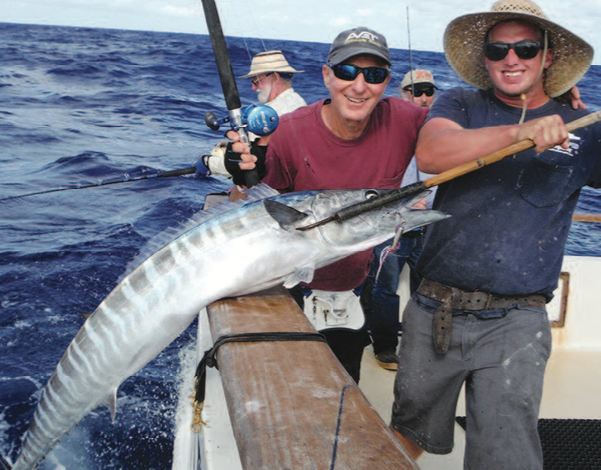
BAIT FISHING FOR WAHOO
Just like nearly every other big gamefish, pin the liveliest sardine or mackerel on your ultra-sharp hook on your pre-rigged wire leaders, gently cast your bait and let it swim freely with your reel in freespool. Forget about long soaks — if you’re not bit within two minutes, change your bait and try again.
The bite will come in one of two ways: You may feel just a slight tap where the wahoo has missiled through, sliced your bait perfectly in half, and swam off with the tail. Resist any urge to strike or reel in any slack line. Fifty percent of the time the wahoo will do a sharp u-turn and inhale the other half — right, the one with the hook in it!
It may even be one of your wahoo’s buddies that sees a free piece of protein and gulps it down. You really don’t care, and as soon as line starts screaming off your reel, point the rod toward the running fish, put the reel in gear and let the drag of the reel set the hook. Only after the wahoo has taken off 30 feet of line under drag should you swing on the fish. Do it hard and do it twice, and be ready to sprint to the left or right at warp speed to follow your wahoo and drive defensively!
Once again, when using jigs and bombs for wahoo I like a stupid-tight drag, but when using bait I like a normal or even looser drag. The number of pre-wired hooks, bombs and jigs you need will depend on your personal game plan — i.e. will you use mostly bait or mostly bombs and jigs? You can assemble all of these right on the boat during the 2 or 3 days’ voyage to the fishing grounds and receive expert instructions from the crew and fellow passengers, or you can begin before the trip. Most long-range boats will also sell you everything you need to assemble your terminal gear, but this is basically what you’ll want to have.
For bait, I suggest starting with 2 to 3 dozen wire leaders of assorted weight and size hooks. Wire leaders should be about 15 inches long, so cut your wire about 18 inches. I’d do most of them in size 1/0, 2/0, 3/0 and 4/0 J-hooks for sardines and a few 5/0 and 6/0 for mackerel, and about a 30/30/30/10 mix of 30-, 45-, 60- and 90-pound for the big baits for good measure.
The large number is not just to account for the large number of cutoffs and casualties associated with wahoo fishing, but if you use the old-style single or multi-strand wire, one wire is usually only good for one strike (win or lose), and you often need to weed out a hundred or more dorado from a kelp paddy before the wahoo — which are schooling be- low the dorado — begin to bite. When the wahoo are very finicky, drop down to 25-pound mono and 30-pound wire, use a small reel and more limber rod, set your drags at 8 pounds and have a blast.
Even if you plan to focus on throwing bombs and jigs, a couple of bait rigs are necessary to use when first arriving at a kelp paddy holding dorado mixed with wahoo. At this time, throwing iron is extremely dangerous as dorado often jump out of the water and shake the hook, sending the jig flying back into the eyes and heads of the anglers. Captains will limit you to bait until the dorado get weeded out and the wahoo begin to show.
But here’s a trick. Keep one bait rod set up with a 4- ounce sliding sinker to get below the dorado if you slide up to a kelp paddy where the captain is metering wahoo and dorado. I have scored several wahoo by dropping my weighted bait right next to the hull at the bow, as far away from the chum as possible to try to get away from the ravenous surface dorado and nail the deeper, waiting wahoo. Again, it is critical to have multiple setups and to focus and specialize on the method you have pre-determined to be your strategy or game plan.
USE THE NEW NON-KINKING WIRE
Knot2Kinky brand wire can be reused as it is much less prone to curling and kinking and stretches to absorb shock. This is truly magical voodoo stuff, and it is the only wire I will ever use again for wahoo (or barracuda sierra mackerel, and sharks). I have caught 5 wahoo on one wire leader. This stuff saves time and money and you are back in the water instantly, adding to your wahoo tally. Even though you can tie a perfection loop knot to secure your hook and swivel or ring, I suggest crimping the “Knot2Kinky” wire anyway.
For those of you stuck with the old technology, you can use the multi-strand wire and crimps but if you can master the haywire twist, I think single-strand wire is more deadly just because it’s thinner and less visible. I suggest double-crimping both ends and running the tag end back through the second crimp a third time and burying it inside that crimp. It’s stronger and will not poke you or the deckhand with the sharp, loose tag end.
You can use a small black swivel or welded ring on the end for the flouro or mono connection. DO NOT use the cheaper stamped rings as they will cut the flouro and mono. Using black swivels will minimize the wahoo biting at the swivel and inadvertently slicing through your mono. Check your rings and swivels for any rough edges and discard any that have them.
TACKLE – RODS AND REELS
Serious wahoo fishing demands more species-specific gear than any other type of big-game fishing. Wahoo will trash any gear that is not built specifically to handle their blistering high-speed runs, and you will lose fish if you can’t keep pace with their erratic turns, always maintaining maximum pressure and always turning the handle.
For jigs and bombs you need rod and reel combos with which you can cast a mile, retrieve at break-neck speed and once hooked up, keep maximum pressure on the fish. High-speed reels with super cranking power and a long stiff graphite rod are musts for jigs and bombs. Great reels for using jigs are the Avet Raptors JX, HX and HXN, Penn Torque 25N – 40 and Daiwa Saltiga 35 size in star or 2-speed models. All have high speed and excellent cranking and torque.
For jigs and bombs you don’t need a 2-speed reel, just a high-speed reel. Fish any 2-speed reel in high gear. Do not switch to low gear be- cause in that split second the wahoo may feel a slight hesitation, spit the hook and say goodbye.
By high-speed, I mean a reel that will retrieve 40 inches or more of line per crank. Small spool diameter reels may be high-speed but don’t pull a jig through the water at 40 inches per turn simply be- cause they’re too small. Depending on spool size, high speeds of 5:1 and 6:1 usually get the job done.
The reel should be super smooth to reduce fatigue because throwing jigs and bombs all day and pulling them through the water as fast as you can possibly crank, and of course, fighting a bunch of mean wahoo is incredibly hard work. A smooth handle will also allow you to “turn the handle” faster, increasing the speed of the jig through the water. Remember, the wahoo does- n’t care about “inches per crank” — they see “inches per second,” which is the definition of speed. Other brands of reels will obviously work, but my favorites listed above are perfect.
There are many great rods for wahoo bombs and jigs. You want a stiff rod that has plenty of back bone and power to muscle against a wahoo. You need a rod long enough to cast your jigs and bombs a mile, strong enough to put super pressure on the fish, fast enough to preclude any line slack when the wahoo shakes, bobs and weaves and light enough to use all day long. Consider the Phenix PHD 760XH or 809XH models, which are 7’ 6” and 8’, respectively and rated for 30- to 80-pound line.
Bait fishing requires a smooth reel with perfect free spool and a strong drag system. The Avet MX Raptor, Penn Torque 25N or Daiwa Saltiga 20 reels and Phenix 760 or 800 PHD-H rod get the job done perfectly. The high speed is not important for bait retrieval, but is still useful to assure the wahoo doesn’t spit the hook, which it will do if there is any nanosecond of slack line. For bait you will want a 40- pound outfit for WFO wahoo fishing and a light 30-pound outfit when the wahoo are picky.
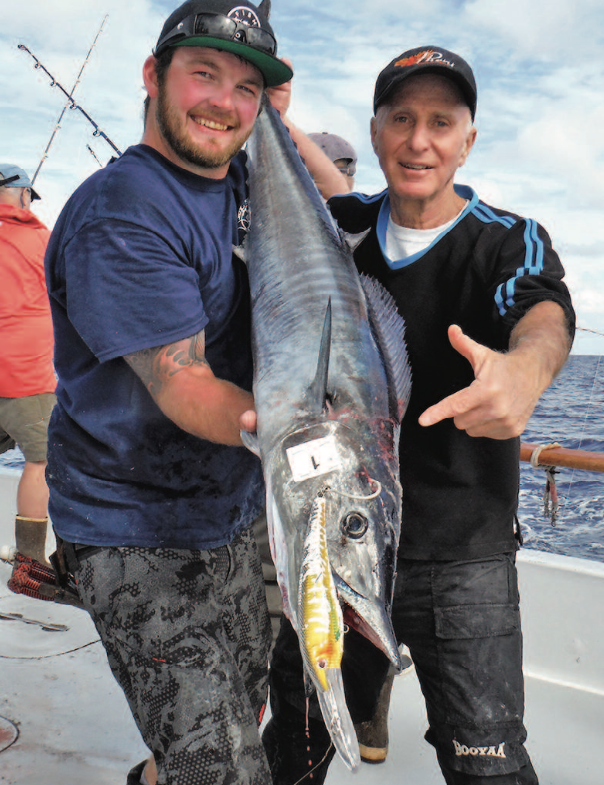
TROLLING
For trolling I generally use the boat gear, but would have total confidence with any tuna trolling outfits. You have obviously heard about the new Nomad DTX 220LR Minnow and the Mad Mac plugs. For 40 years, the Mauraders, cowbells and Catchy Spinner blade trolling plugs were the mainstays for trolling for wahoo.
But over the last four years if you were using one of those oldie-but-goodie models and your trolling teammate had a Nomad DTX220LR, your chance of getting bit was re- reduced by 90%. I definitely suggest you bring several on board just in case the boat doesn’t have any.
GAME PLAN
OK, we now have the right gear and the terminal tackle. Develop- ing a game plan is critical. You need to have a personal strategy to optimize your tackle and maximize your chances to land the greatest number of wahoo. Decide this before you get on the boat. Don’t wait until the first jig strike and the ensuing frenzy and chaos.
Be honest with yourself. Do you love fishing bait? Do you love casting jigs? If you can’t cast worth beans, now is NOT the time to learn. Practice at home, at the pond, at the park, but not when the wahoo are biting! Don’t even think about bombs and jigs unless you are very proficient at casting and have the correct gear as outlined above. Don’t waste this very precious and limited time and opportunity.
It is critical to allocate your tackle resources efficiently. If you are going to specialize on throwing bombs and jigs, have at least three or four setups pre-rigged with bombs and jigs. Have just one or two set up for bait. If you are not throwing jigs, have at least four setups rigged for bait.
I can’t emphasize the need for extra or redundant outfits enough for serious wahoo fishing. Assuming there are wahoo rampaging in the water, you will lose a lot of wahoo and terminal gear due to:
1. Spit outs
2. Chew offs – even with wire leaders!
3. Cut-offs or saw-offs
4. Landing a damn dorado or tuna and getting a curly cue wire (one wire is good for one fish of any species — unless you get the new magical Knot-2-Kinky wire).
5. Even when you land a wahoo (Yeah, team!) your wire will be kinked and will need to be replaced unless you are using the Knot-2- Kinky product.
Regardless of the above reasons, you want to immediately get back in the water with another bait, bomb or jig, which is why having multiple setups is absolutely critical. Also, if you are casting bombs and jigs you don’t want to take the time to re-tie just to switch to another color or pattern if yours is being ignored while something else is being consistently slammed.
Having duplicate or redundant setups is so crucial it is worth renting the appropriate gear if you are new to wahoo fishing and have not yet ac- quired sufficient backups in your personal arsenal. It is absolutely critical to have all gear re-tied and ready to go before the next trolling jig stop or arrival at the next kelp paddy. Again, this is also why I love the Knot-2-Kinky wire. Redundancy and readiness are critical — just grab another rod and get another wahoo.

